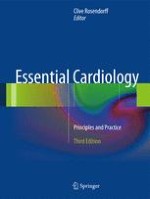Gepubliceerd in:
2013 | OriginalPaper | Hoofdstuk
21. Pathogenesis of Atherosclerosis
Abstract
Atherosclerotic vascular disease is a leading cause of death and disability throughout the USA and other industrialized nations and consumes enormous fiscal resources. Atherosclerosis involves the development of a plaque composed of variable amounts of atherogenic lipoproteins, extracellular matrix (collagen, proteoglycans, glycosaminoglycans), calcium, vascular smooth muscle cells, inflammatory and immune cells (chiefly monocyte-derived macrophages, T lymphocytes, mast cells, dendritic cells), and new blood vessels. Atherosclerosis represents a chronic inflammatory response to vascular injury triggered by a variety of risk factors that injure endothelium and promote lipoprotein infiltration, retention, and modification, combined with leukocyte entry, retention, proliferation, and activation. Atherosclerosis predisposes to arterial thrombosis and acute arterial occlusion when plaque disruption leads to activation of the clotting cascade in the vasculature. Ultimately, most lethal and significant occlusive cardiovascular events result from plaque disruption leading to thrombosis. Disruption of plaques is believed to result from inflammation and immune activation in the plaque leading to matrix degradation and inadequate repair. Inflammation plays a crucial role in the initiation, progression, and eventual destabilization of atherosclerotic plaques. Disruption-prone plaques generally contain large necrotic lipid core with adventitial remodeling, plaque cap inflammation, increased neovascularity, and intraplaque hemorrhage.
